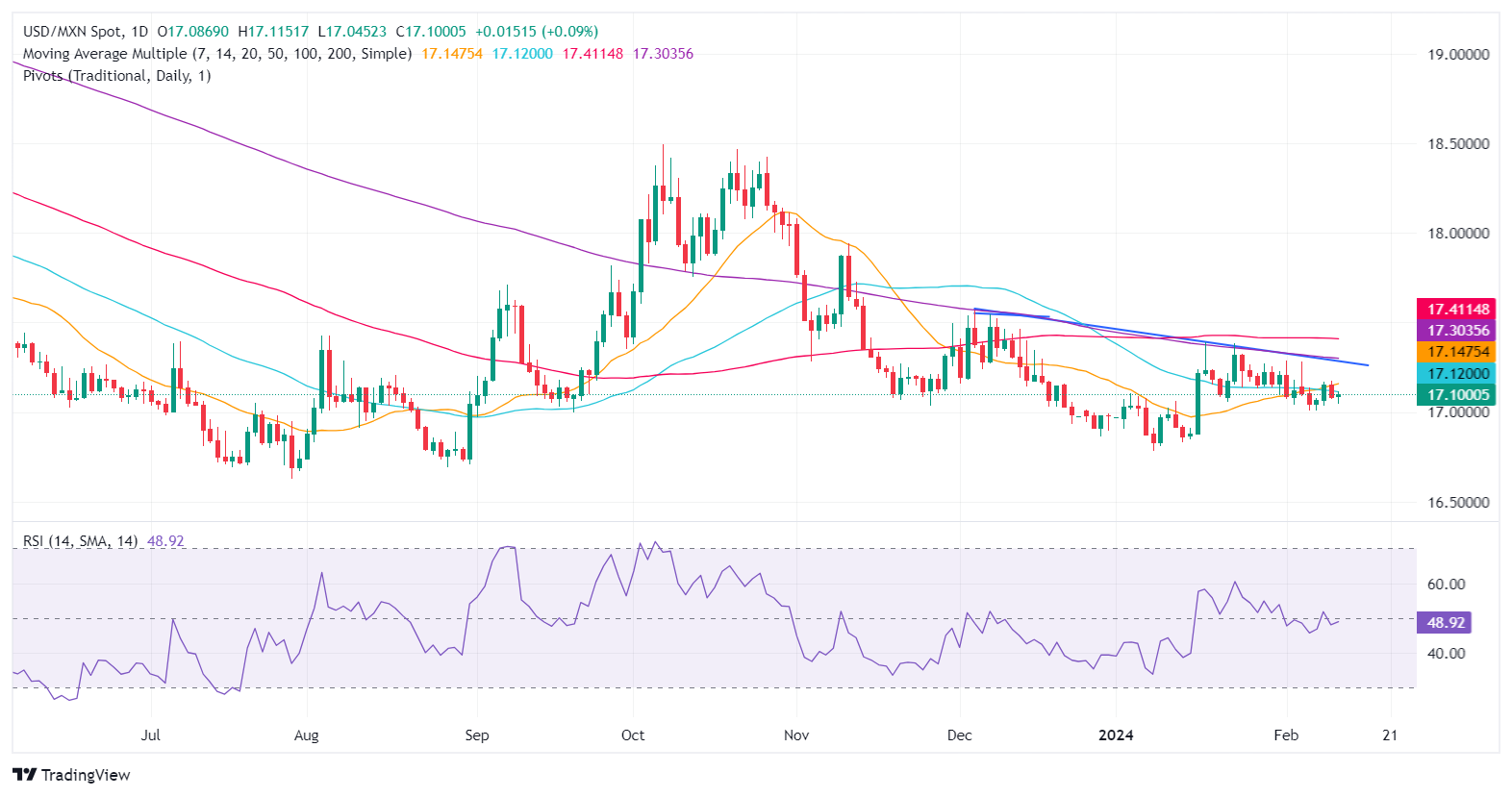Mexican Peso aims higher ahead of US inflation data
- Mexican Peso extends gains for a third session, buoyed by central banker’s remarks.
- Banxico Governor's comments on inflation and easing hint at policy shifts as MXN gathers traction.
- NY Fed's Consumer Inflation Expectations for one year in January remained steady.
Mexican Peso (MXN) finishes Monday’s session up, clocking modest gains versus the US Dollar (USD) amid a mixed market sentiment, as traders brace for safety ahead of the release of January’s inflation report in the United States (US). US Treasury bond yields edged higher and underpinned the Greenback (USD), capping the USD/MXN upside. At the time of writing, the exotic pair exchanges hands at 17.07, down 0.09%.
Mexico’s economic docket featured a speech by Banxico’s Governor Rodriguez, who spoke about inflation and the likelihood of easing monetary policy. Across the border, the calendar featured the New York Federal Reserve’s one-year Consumer Inflation Expectations registering at 3%, unchanged compared with December.
Daily digest market movers: Mexican Peso is firm ahead of US inflation report
- In an interview with El Financiero, Banxico’s Governor, Victoria Rodriguez Ceja, said that inflation is expected to return to its downward trajectory and continue the disinflationary process. She added that despite increasing in the last three months, the Mexican central bank sticks to its vision that inflation will hit its 3% goal in 2025.
- Rodriguez Ceja added that despite lowering interest rates during the year, the bank remains focused on inflation. She added, “The inflationary episode has been evolving, and the situation we find ourselves in now is very different from the one we experience in 2022, even in the first months of 2023.”
- Rodriguez Ceja said the bank would make its decision based on various factors and data, including Fed’s decisions.
- Mexico’s central bank revised their inflation expectations to the upside for Q1 to Q3 of 2024, and they expected to converge toward 3.5% in Q4, based on the latest monetary policy statement.
- Last Thursday, INEGI revealed that in January, Mexico´s Consumer Price Index (CPI) rose by 4.88% YoY, while underlying inflation moderated to 4.76%.
- Atlanta Fed President Raphael Bostic said the Fed must be resolute and added that he’s “laser-focused” on inflation. At the same time, Dallas Fed President Lorie Logan noted that there’s no urgency on cutting rates.
- The US Bureau of Labor Statistics (BLS) will release inflation data on February 13. The Consumer Price Index (CPI) for January is foreseen dipping from 3.4% to 2.9% YoY. The Core CPI is expected to dip from 3.9% to 3.7% on an annual basis.
Technical analysis: Mexican Peso stays firm as USD/MXN remains below 17.10
The USD/MXN is neutral to downwardly tilted with sellers eyeing a break below 17.00. Relative Strength Index (RSI) studies suggest that bears are in charge, but the slope is turning somewhat flat. If sellers push prices below 17.05, that could open the door to test the psychological 17.00 figure. A breach of the latter could pave the way to challenge 2023 low of 16.62.
On the other hand, if buyers reclaim the 50-day SMA at 17.11, that can pave the way to test the 200-day SMA at 17.29. Upside risks emerge once that barrier is cleared with the following supply zone coming at 17.40, the 100-day SMA.
USD/MXN Price Action – Daily Chart

Inflation FAQs
What is inflation?
Inflation measures the rise in the price of a representative basket of goods and services. Headline inflation is usually expressed as a percentage change on a month-on-month (MoM) and year-on-year (YoY) basis. Core inflation excludes more volatile elements such as food and fuel which can fluctuate because of geopolitical and seasonal factors. Core inflation is the figure economists focus on and is the level targeted by central banks, which are mandated to keep inflation at a manageable level, usually around 2%.
What is the Consumer Price Index (CPI)?
The Consumer Price Index (CPI) measures the change in prices of a basket of goods and services over a period of time. It is usually expressed as a percentage change on a month-on-month (MoM) and year-on-year (YoY) basis. Core CPI is the figure targeted by central banks as it excludes volatile food and fuel inputs. When Core CPI rises above 2% it usually results in higher interest rates and vice versa when it falls below 2%. Since higher interest rates are positive for a currency, higher inflation usually results in a stronger currency. The opposite is true when inflation falls.
What is the impact of inflation on foreign exchange?
Although it may seem counter-intuitive, high inflation in a country pushes up the value of its currency and vice versa for lower inflation. This is because the central bank will normally raise interest rates to combat the higher inflation, which attract more global capital inflows from investors looking for a lucrative place to park their money.
How does inflation influence the price of Gold?
Formerly, Gold was the asset investors turned to in times of high inflation because it preserved its value, and whilst investors will often still buy Gold for its safe-haven properties in times of extreme market turmoil, this is not the case most of the time. This is because when inflation is high, central banks will put up interest rates to combat it.
Higher interest rates are negative for Gold because they increase the opportunity-cost of holding Gold vis-a-vis an interest-bearing asset or placing the money in a cash deposit account. On the flipside, lower inflation tends to be positive for Gold as it brings interest rates down, making the bright metal a more viable investment alternative.